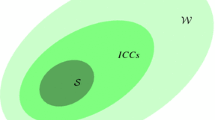Abstract
The paper studies equilibrium contracts under adverse selection when there is repeated interaction between a principal and an agent over an infinite horizon, without commitment across periods. We show the second-best contract is offered in a perfect Bayesian equilibrium of the infinite horizon model. Unlike the equilibrium contracts in the finite-horizon, the equilibrium contracts in the infinite horizon are not subject to either the ratchet effect or take-the-money-and-run strategy, but rely on a carrot and stick strategy. We study two important applications, one of which is about the optimal regulation of a publicly-held firm. This application has a mixture of both moral hazard and adverse selection. The other application is to the problem of optimal nonlinear pricing when the valuation of the buyers are drawn from a continuum.
Similar content being viewed by others
Notes
This is especially the case when it involves buyers and sellers as the buyer can choose not to buy and there is less scope to write long term binding contracts.
It may be of interest to note that in the Laffont and Tirole (1988), there is no possibility of any kind of separating equilibrium in the two-period model, indicating a particularly sharp contrast to the infinite horizon case.
For a full and comprehensive discussion of the second-best optimal contract for the continuum of type case see (Laffont & Martimort, 2002), Appendix 3.1, pages 134 to 140.
See for example equation 3.145, page 138 of Laffont and Martimort (2002).
It is important to note that the expected payoff of the principal from a menu \(m_t\) offered in period t, is dependant on the past history which determines the updated beliefs of the principal.
The agent’s type, which the agent learns at the beginning of period 1, stays the same throughout, so the agent knows his type at the beginning of period t.
Note that as this is a game with incomplete information it can also be viewed as a game with imperfect information, in which a chance move by nature who selects the type of the agent at the beginning of the game cannot be perfectly observed by all the players.
It is well known that with full commitment across periods the optimal contract that the principal can offer is the second-best optimal contract.
Note that \({{\hat{q}}}(\theta )\) is the output in the menu of contracts offered in period 1. This is the output for type \(\theta \) in the second-best contract.
It is possible that there is a \(\theta ^\star > {{\underline{\theta }}}\) such that for all \(\theta \le \theta ^\star \), \((S({{\hat{q}}}(\theta )) - {{\hat{P}}}(\theta ))) = 0\) and \((S({{\hat{q}}}(\theta )) - {{\hat{P}}}(\theta ))) > 0\) only for \(\theta > \theta ^\star \). In that case, the contracts are only offered to types \(\theta \ge \theta ^\star \).
That is, the principal offers a contract that leaves zero information rent to the agent.
The rationale for this is that if the agent does not carry out the full punishment phase, then the principal is encouraged to offer a contract that extracts a lot of surplus from the agent.
The gain of the principal depends on the type of the agent so M should be considered the maximum gain for all possible types of the agent.
Again the loss of the agent will depend on the type of the agent so \(L_A\) is the maximum loss for all possible types.
This therefore assumes that the agent with the highest cost produces a positive surplus.
This is the distribution function when the updated belief system is given by the Dirac Measure \(\delta _{{{\tilde{\theta }}}}\).
As before, we do not specify the updated beliefs when \(\theta \not = {{\tilde{\theta }}}\) for \(\theta \in [{{\underline{\theta }}}, {{\bar{\theta }}}]\) as this occurs with probability zero in equilibrium.
Note that \({{\hat{q}}} = q_\ell ^{SB}\) for some \(\ell \) and is one of the outputs in the menu of contracts offered in period 1.
Here it may be useful to interpret the discount factor \(\delta \) as the probability with which the buyer comes back to the seller. It is also worth mentioning that in this case the condition that there is no commitment across periods is important as the buyer can always choose not to trade in the future.
Such contracts are quite common in the telecommunications industry in which a buyer can choose from a menu that includes an option in which the buyer has unlimited minutes, but with a higher monthly fee, as well as an option with a fixed number of minutes with a lower monthly fee. The contract is valid for a limited time, and the buyer is free to leave or choose a different contract after that. The seller too can change the terms of the contract in the next period, thus there is no commitment across periods. The buyer can also choose to stay with the seller for many periods.
For example the Hilton Honors program can be viewed from this perspective. Airlines too frequently find ways to reward the consumers who show a preference for higher quality, or more frequent use of the services.
References
Battaglini, M. (2005). Long-term contracting with Markovian consumers. American Economic Review, 95(3), 637–658.
Bolton, P., & Dewatripont, M. (2005). Contract Theory. MIT Press.
Chakrabarti, S. K. (2010). Optimal collusion in cournot oligopolies with unknown costs. International Economic Review, 51, 1209–1238.
Chakrabarti, S. K., & Kim, J. (2015). Equilibrium contracts in Repeated Adverse Selection (p. 2015). Department of Economics, IUPUI, August: Mimeo.
Espinosa, M., & Rhee, C. (1989). Efficient wage bargaining as a repeated game. Quarterly Journal of Economics, 104, 565–588.
Fudenberg, D., & Maskin, E. (1986). The folk theorem in repeated games with discounting or with incomplete information. Econometrica, 62, 997–1039.
Fudenberg, D., & Tirole, J. (1991). Perfect Bayesian equilibrium and sequential equilibrium. Journal of Economic Theory, 53, 236–260.
Gerardi, D., & Maestri, L. (2020). Dynamic contracting with limited commitment and the ratchet effect. Theoretical Economics, 14(2), 583–623.
Hart, O., & Tirole, J. (1988). Contract renegotiation and Coasian dynamics. Review of Economic Studies, 55, 509–540.
Laffont, J. J., & Martimort, D. (2002). Theory of Incentives. Princeton University Press.
Laffont, J. J., & Tirole, J. (1988). The dynamics of incentive contracts. Econometrica, 56, 1153–1175.
Laffont, J. J., & Tirole, J. (1993). A theory of incentives in procurement and regulation. MIT Press.
Radner, R. (1981). Monitoring cooperative agreements in a repeated principal relationship. Econometrica, 49, 1127–1148.
Radner, R. (1985). Repeated principal-agent games with discounting. Econometrica, 53, 1173–1198.
Spear, S. E., & Srivastava, S. (1987). On repeated moral hazard with discounting. Review of Economic Studies, 54, 599–617.
Rubinstein, A., & Yaari, M. (1983). Repeated insurance contracts and moral hazard. Journal of Economic Theory, 30, 74–97.
Author information
Authors and Affiliations
Corresponding author
Additional information
Publisher's Note
Springer Nature remains neutral with regard to jurisdictional claims in published maps and institutional affiliations.
Rights and permissions
About this article
Cite this article
Chakrabarti, S.K., Kim, J. Optimal equilibrium contracts in the infinite horizon with no commitment across periods. Theory Decis 94, 379–404 (2023). https://doi.org/10.1007/s11238-022-09894-9
Accepted:
Published:
Issue Date:
DOI: https://doi.org/10.1007/s11238-022-09894-9




